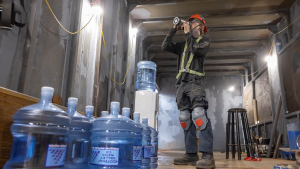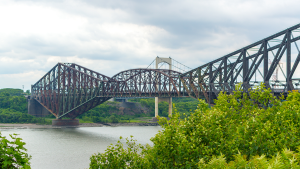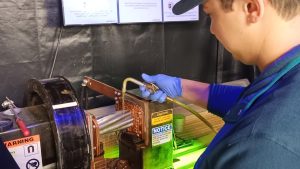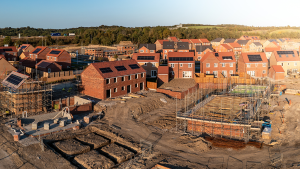Clean drinking water and efficient wastewater treatment would seem to be a given in an industrialized country like Canada, but for those in the far north it’s a different story.
Clean drinking water and efficient wastewater treatment would seem to be a given in an industrialized country like Canada, but for those in the far north it’s a different story.
That’s why the opening of the Kingfisher Lake First Nation’s water treatment plant last year marked a giant step for the tiny community of less than 500 people north of Thunder Bay and closer to the Manitoba border than any other Ontario town.
While the plant itself is a fairly simple construction and the conventional treatment technology a common method, the project was not without a few challenges, said Ran Reimer, the project manager for Penn-Co Construction of Manitoba which specializes in remote installations.
“There’s no road in,” he says. “So everything had to be trucked in during the winter (when the lakes freeze) and we had to anticipate every last nut and bolt we would need.”
As it was, the project only had a couple of minor glitches which set the schedule back but it was completed in a year almost exactly, he said.
Because of the community’s relative isolation, the water treatment plant had to be almost bulletproof to run since getting skilled technical help on a moment’s notice is always going to be an issue.
“There are still chemicals to be mixed and applied but a conventional system is pretty basic and there are millions of them in use,” he said, comparing the technology to sand and membrane-style treatment facilities.
With three Penn-Co employees directing the work, the local community provided the labour starting in April 2008.
“First thing we did was blast the rock for the building,” said Reimer. “It’s all bedrock, there so we had no choice.”
Chief James Mamakwa said the blasting was a popular community event and not an everyday occurrence.
“It was pretty exciting,” he laughed.
“But they did a good job covering the ground with blast mats, so things didn’t go everywhere.”
From there construction went on as normal, though as Mamakwa notes there were some challenges getting the concrete floor to be seamless.
The building was a simple steel frame structure with steel walls, said Reimer, and because the new plant was built beside the existing plant, little in the way of new blasting to lay pipes was needed.
“We had a bit to do for the tie-in but not much,” he explained.
In fact, Chief Mamakwa said the community tried to get additional pipes laid but were unable to get funding and support.
“Even with this plant, only 50 per cent of the community has piped-in water,” he says. “Some 50 per cent still have it trucked in and that’s very expensive.”
He says the issue is that laying pipe will involve a lot of blasting because the community is built on bedrock. That’s the only way to protect it from the constant minus 25C temperatures in winter.
In 2001 a survey of the community found it in dire need of water treatment, with 202 people using piped water and 189 having trucked-in water and four having no water at all.
Similar numbers were found with sewage treatment, making the community a high priority target for federal government funding for upgrades.
Indian and Northern Affairs Canada provided Kingfisher Lake First Nation with $8.3 million for the new plant. The First Nation managed planning, design, construction and commissioning of the facility. Changes to operations and processes were also implemented. The new facility currently has excess capacity which will enable it to meet future water demands. “This will allow us to at least sustain our community and even grow,” said Mamakwa.
The community itself dates back several hundred years and used to trade at the Hudson’s Bay Company outpost at Big Beaver House which is about 12 kilometres south. The post was established in 1808.
Things went mostly according to plan and there were only a couple of items that needed to be flown in.
“There’s always something,” he recalled.
“But it’s not as isolated as it seems and it’s a really nice community up there. The labour force was good and they were amicable and willing and ready to work.”












Recent Comments
comments for this post are closed